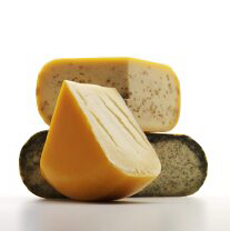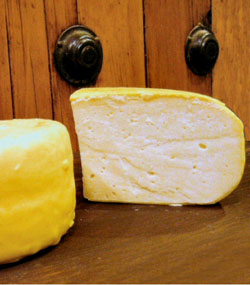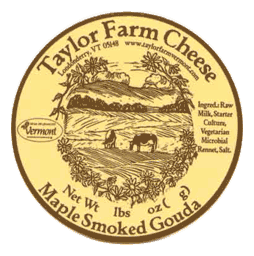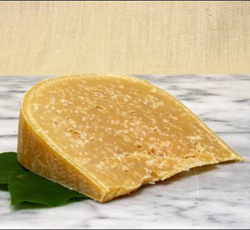

Flavored Gouda cheeses from Marieke. Photo courtesy Wisconsin Milk Marketing Board.
|
STEPHANIE ZONIS, Contributing Editor, focuses on good foods and the people who produce them.
|
|
February 2008
Last Updated March 2012
|
 |
Best Gouda Brands
Page 6: Reviews Of 13 Gouda Brands (Continued)
- Click here to read other months’ Whey To Go columns
This is Page 6 of a six-page article on Gouda. Here, we taste 13 Gouda brands.
Tasting The Goudas
- Meadow Stone Farm Di Greta Gouda,* Connecticut. Yellow beeswax coating. A raw milk Gouda from the milk of Jersey cows; mine had been aged for three or four months. A delicate, cream-colored paste with many tiny eyes. Multidimensional flavor and a noticeable tang, which the cheesemaker tells me is due to the cows’ pasture-based diet. A very nice younger Gouda, made by a delightful couple with some passionate views about food.
- Royal Hollandia Gouda, imported from The Netherlands. Red wax coating. Smooth appearance, moderately yellow paste. Buttery texture with some salt and a slight tang but no other real flavor until the aftertaste, which is somewhat bitter and lasting, kicks in. Supermarket purchase.
|
|
 Meadow Stone Farm Gouda shows its “eyes,” or holes. These are formed in a late stage of the cheesemaking process, when bacteria consume lactic acid and release carbon dioxide gas. This forms the bubbles or “holes.” The cheese industry calls these holes “eyes.” Meadow Stone Farm Gouda shows its “eyes,” or holes. These are formed in a late stage of the cheesemaking process, when bacteria consume lactic acid and release carbon dioxide gas. This forms the bubbles or “holes.” The cheese industry calls these holes “eyes.”
|
- Swiss Connection “Intermediate” Aged Flora,* Indiana. No wax coating. Although the cheese is listed as “Gouda” on the website as of this writing, technically, its name has been changed to Flora. This is a raw milk, farmstead (boeren kaas) Gouda from strictly grass-fed cows; mine had been aged for about six months. Deep yellow paste, few eyes, with the easy-slicing texture of a young cheese. Nose-fillingly aromatic in a very pleasant way. There are a multitude of different flavors going on here, though nothing is too sharp, and the layers of tastes are a delight. At present, you must call to order.
- Taylor Farm Maple Smoked Gouda,* Vermont. Thick brown wax coating. Definite smoke aroma. Paste is a pale yellow shot through with many small holes. I was really surprised by this product. Historically, I haven’t cared for smoked cheeses, but the delicate smoky taste here doesn’t knock you over; it merely adds an unexpected and delicious note to the flavor.
|
|
 |
- Vintage Special Edition Gouda, imported (origin unspecified). No wax coating. Deep amber paste, much harder and more crumbly than a young Gouda. Strong, mouth-filling flavor, and quite salty, with a caramelized presence. Strong aroma, as well. A few tyrosine crystals provide an occasional bit of crunch. Supermarket purchase. A classic aged Gouda.
- Winchester Cheese Super Aged Gouda,* California. No wax coating. This is a raw milk, farmstead Gouda, or boeren kaas. It looks a little like a Parmigiano-Reggiano, with its darker straw-colored paste, and it cuts very like one, too, in that this cheese is on the crumbly side. It even starts out similar to a Parmigiano in flavor, but the taste turns quickly to a presence just skating on the edge of intense bitterness.
|
|

Photo courtesy Winchester Cheese. |
| |
EDITOR’S NOTE: We did not eat the same wedge of cheese as the author, but have had it several times and did not find any bitterness—just nuttiness, with sweet and salty tones. While the author does not recommend this cheese (photo at right), we would, based on the different samples we tried. It is aged 15 months or more, and won a Second Place Ribbon in the Gouda Category at last summer’s American Cheese Society Competition. The company also makes a Medium Gouda, aged for at least three months and a Sharp Gouda, aged for at least six months, by which time the tyrosine crystals you can see in the photo begin to develop. |
Tasting Party
If you want to get to know Gouda, do what I often do with cheeses: have a tasting, alone or with other cheese lovers. It’s a great way to learn about what you like and don’t like (both are equally important), and it’s a lot of fun.
- Buy several different kinds of Goudas, including a mass-produced version and a few farmstead and/or artisan-made varieties, preferably of different ages.
- Cut samples from all of the cheeses and let them come to room temperature, then taste them, starting from the younger, milder Goudas and working your way up.
- Write down your reactions to each cheese (few people can remember without tasting notes).
- Be sure to clear your palate between samples (water and bread or water biscuits like Carr’s are good bets).
You’ll learn more by doing this than you can via most other cheese education methods. If you have leftover cheese, you’ll enjoy it on sandwiches, melts and the other options discussed earlier. Go Gouda!
Go To The Article Index Above
Sources
Lifestyle Direct, Inc. All rights reserved. Images are the copyright of their respective owners.

|







